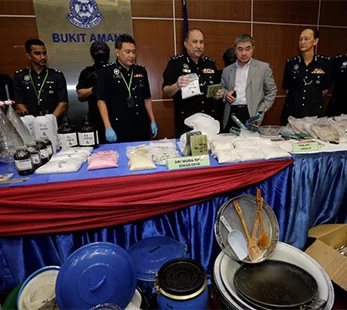MALAYSIA’S National Drug Policy has seen encouraging results in the last decade due to the introduction of harm reduction programmes.
These programmes consist of needle and syringe exchanges,and methadone maintenance therapy to reduce the risk of infections such as HIV and hepatitis.
However, harm reduction alone is not enough to end drug abuse in Malaysia. There must be a shift in mindset about how we as a society think about drug addiction and rehabilitation. Drug abuse should be viewed as a health and social issue —addiction should be seen as a disease, rehabilitation as treatment and addicts as patients. This change in ideology will help to narrow the focus of the country’s drug policy.
FIRST, there should be a clear distinction between addicts, pushers, dealers and traffickers.
Accurate data should be collected, in terms of who is addicted, the areas in which addiction is most rampant, and the type of drug users in the country. This will help to improve law enforcement and public health with regard to drug abuse.
Viewing addicts as patients will free up the capacity of law enforcement, which will enable them to go after the big fish —those responsible for producing and distributing drugs in the country.
As stated by the Royal Malaysia Police in September last year, the National Drug Policy should be amended to address drug trafficking in greater detail, specifically in terms of detaining petty drug dealers for longer periods.
The Inspector-General of Police Tan Sri Khalid Abu Bakar also stated that the Dangerous Drugs Act 1952 does not take into account new methods of drug production —“The drugs will be blended (with other substances) so that they will not be included as dangerous drugs as outlined in the Act,” he said.
Going after the black market of drug distribution is crucial, as it results in the production of “fake” drugs —those that are cheaper with different levels of purity. This only leads to greater distribution and health risks.
SECOND, if law enforcement is primarily focused on the big fish, more resources will be available to support drug rehabilitation.
For example, more community based centres, support systems, outreach workers and training are needed to run harm reduction programmes.
A study published in The Lancet Global Health in December last year concluded that drug addicts at Narcotics Addiction Rehabilitation Centres (Puspen) —who undergo the cold turkey approach —are more likely to relapse than those in the voluntary Cure and Care Centres. According to the study, only 10 per cent of addicts in Puspen were drug-free after a year, compared with 50 per cent at the Cure and Care Centres.
There could also be an increase in medication-assisted treatment, such as methadone to curb heroin addiction and naloxone to reverse the effects of an overdose.
A study funded by the World Bank and conducted by Universiti Malaya’s Centre of Excellence for Research in AIDS in July 2014 concluded that Malaysia’s harm reduction programmes are cost-effective and cost-saving, with return on investments for the government. Specifically, the study indicated that harm reduction can save the government RM47.1 million in healthcare costs.
This amount can be reallocated for the purposes mentioned above, as well as research on new drug rehabilitation measures, in terms of the methods or best practices adopted in other countries that can be applied here.
THIRD, if addiction is seen as a disease, it alleviates the social stigma that is associated with drug abuse.
Society is either afraid to deal with addicts, which prevents help altogether, or addicts hesitate to ask for help, as most believe it will result in negative reactions. In other words, there is a strong correlation between social stigma for drug use and treatment seeking behaviour, which results in drug policies being under utilised.
A shift in mindset about how we approach drug abuse should break this connection. It could encourage more addicts to approach the voluntary Cure and Care Centres whichhave lower relapse rates than detention centres.
Drug rehabilitation also encompasses more than just the cold turkey approach or harm reduction programmes. Getting someone off drugs is only step one. Once a person is “clean”, there are the added tasks of reconnecting with family, finding employment or seeking further treatment like counselling to address the psychological issues that led to addiction in the first place. A holistic rehabilitation programme is not possible if the social stigma of drug use is prevalent.
A shift in mindset does not constitute a soft stance on drug abuse. Malaysia remains one of the toughest countries in the world when it comes to drugs. But we must do more than just say no to drugs. Changing the way we view drug abuse is simplya different approach to achieve the same goal.





